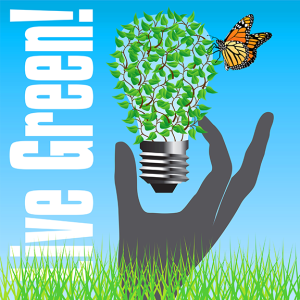With the beginning of another year comes a slew of too-frequently abandoned New Year’s resolutions. Some of the most popular New Year’s resolutions are to lose weight, quit smoking, save money, manage stress, drink less alcohol and reduce, reuse and recycle.
All of these are great choices! Unfortunately, of those we listed, only the last one was not also on the list of most commonly broken New Year’s resolutions.
No matter what you resolved to do this year, we hope you’ll stick with it! If your resolution was to reduce, reuse and recycle (or anything else pertaining to a green lifestyle), we’d like to help you out by providing this list of simple ways to live a greener life in 2015. Don’t worry about starting them all at once; that’s a sure recipe for failure. Instead, pick one and work on it until it becomes part of your routine, and then move on to the next one.
Simple Ways to Live Greener
1. Persistently Paperless
In today’s world of computers, it can be easy for many people to go a day without using a single piece of paper. Think about why this can be a good thing: if everybody uses less paper, we can produce less paper, which means that fewer trees will need to be cut down to make paper. Additionally, we need to recycle more of the paper we use. According to the EPA, we can save 17 mature trees by recycling one ton (.91 metric tons) of paper. Recycling keeps paper waste out of our landfills, but it also takes less energy to create paper through recycling than it does to create new paper from wood pulp. Sounds like a win-win to us!
2. Paper or Plastic? Neither!
There are a growing number of countries, counties and cities that are prohibiting the use of single-use plastic bags or are imposing a tax on single-use plastic and/or paper bags. Until the rest of the world catches up though, it’s up to the individual to make this choice in many localities. Investing in reusable bags is a good way to go green. However, not all reusable bags are created equal. They can be made of a variety of materials including cotton, hemp, jute and various forms of plastic. Each material has its benefits and disadvantages, but we would suggest using those made of natural fibers over those made of plastics.
3. Buy Better Light Bulbs
Since about the mid-90s, compact fluorescent lamp (CFL) light bulbs had been being pushed as a green alternative to traditional incandescent bulbs. They last longer and run on less energy, making them the obvious choice between the two. However, in recent years, a new player has come on the scene. Light Emitting Diode (LED) light bulbs, while relatively expensive, are actually designed to use even less power and last even longer than CFL light bulbs.
4. Clean With Cloth
The next time you reach for the paper towels to clean up a mess, think twice. Grab a rag instead. Doing so can help save even more trees and make the world a greener place. Rags can be made out of just about any cloth product that you were going to throw away and can be used for a very long time. This includes old t-shirts, towels and other items. Used rags can be kept in a basket until you have enough of them to constitute a laundry load so that you’re not washing them individually.
5. Borrow, Don’t Buy
It’s easy to waste money on items that you could borrow just as easily. You can get books from the library and rent movies (or you can buy digital copies of books and movies or stream movies online). If you feel that you need to own these items, you can purchase them later second hand, saving you money and keeping items out of the landfills.
6. No Wasting Water
Using less water and cutting back on bottled water purchases can have a great positive impact on the environment and your wallet. Taking shorter showers, installing low-flow water systems and investing in a water filtration system can all save you money on your water bill and help you waste much less water.
7. Energy Efficiency
No matter how green the energy you have access to is, using less of it is going to be good for the environment. A few tips for using less energy are to turn the thermostat down in the winter and up in the summer, unplug appliances and electronics that aren’t currently being used, wash all possible clothes in cold water, and use a drying rack or clothesline to dry your clothes.
8. Commence Composting
Composting has become fairly common in the U.S. the last few years, and for good reason! It reduces waste, saves money, and can help you grow better plants in your garden. Items that you would otherwise be throwing away can be turned into rich compost. This can allow you to avoid buying expensive compost for the gardening needs of you or your friends and family.
Think Outside the Box
Most of these ideas you’ve probably heard before. Going green isn’t a new idea, but sometimes we need a little reminding. Maybe you’d like to try something a little bit different this year. If so, you could try helping the environment by buying nature-based and compostable products for your home or business to replace items that aren’t good for the environment. You can buy compostable cutlery made from potatoes or bowls made from bamboo.
However you decide to go green this year, we hope you’ll keep going and not break that New Year’s resolution!
Sources:
http://www.usa.gov/Citizen/Topics/New-Years-Resolutions.shtml
http://content.time.com/time/specials/packages/completelist/0,29569,2040218,00.html

